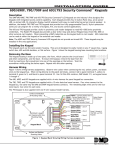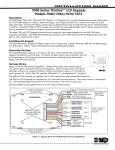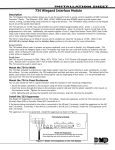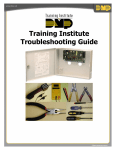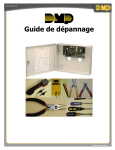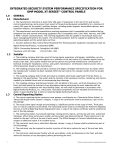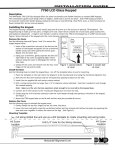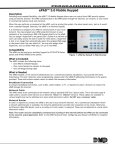Download DMP Electronics Security Command 690 Specifications
Transcript
INSTALLATION SHEET 690/690F, 790/790F Security Command® Keypads 791/793 Easy Entry™ Keypads Description The DMP 690/690F, 790/790F Security Command® LCD Keypads and 791/793 Easy Entry™ LCD Keypad are the industry’s first burglary/fire keypads with integrated access control capability. Each keypad provides four 2-button Panic keys, an AC power LED, an Armed LED, 32-character display, backlit keyboard with easy-to-read lettering and an internal speaker. The 790/790F and 791/793 keypads provide four fully programmable Class B, Style A protection zones you can program for a variety of burglary, fire, and access control applications. The 793 keypads also provide a built-in card reader. Note: The 690F and 790F Security Command LCD keypads do not provide an Armed LED. These keypads may be installed in fire only applications. Installing the Keypad The keypads each use the same plastic housing. They are all designed to easily install on any 4” square box, 3-gang switch box, 695 and 696 backbox, or flat surface. Figure 1 shows the keypad housing base mounting hole locations. Removing the Base The keypad housing is made up of two parts: the front, which contains the circuit board and other components, and the base. To mount the keypad, remove the base from the front by inserting a flat screwdriver into one of the openings on the bottom. Twist the screwdriver while pulling the halves apart. Repeat with the other opening. Harness Wiring Figure 1 shows wiring harness assignments. Observe wire colors when connecting the red, yellow, green, and black wires to the keypad bus. When wiring directly to the panel terminals, connect red to panel terminal 7, yellow to terminal 8, green to 9, and black to panel terminal 10. Use 1k Ohm EOL resistors, DMP Model 311, on keypad zones 1 through 4. The 690 and 690F keypads are supplied with a 4-wire harness for panel keypad bus connection. The 790, 790F, and 791/793 keypads are supplied with a 12-wire data bus/zone harness. Four wires connect to the keypad bus, the same way the 690 and 690F keypad harness connects. The remaining eight wires are for the four zone inputs: two wires for each zone. The 791/793 keypad is also supplied with one 5-wire output/reader harness. Surface and Backbox Mounting Holes Combined 4-square and 3-gang switch box Mounting Holes Keypad Back Green/White – Connect Reader Data 0 White – Connect Reader Data 1 Orange – Door Strike Normally Open Gray – Door Strike Common Violet – Door Strike Normally Closed 1K EOL Yellow/White – Zone 4 White/Yellow 1K EOL Orange White – Zone 3 White/Orange 1K EOL Red/White White/Red 1K EOL Brown/White – Zone 1 White/Brown Black – Ground Green – Receive Data Yellow – Send Data Red – Keypad Power – Zone 2 All Keypads Surface and Backbox Mounting Holes Figure 1: Keypad Back Showing Wiring Harness Assignments Output Reader 791/793 Keypads Zones 1 through 4 790/790F, 791 and 793 Keypads Wiring Specifications When planning a keypad bus installation, keep in mind the following specifications: 1. DMP recommends using 18 or 22-gauge unshielded wire for all keypad and LX-Bus circuits. Do Not use twisted pair or shielded wire for LX-Bus and keypad bus data circuits. To maintain auxiliary power integrity when using 22-gauge wire do not exceed 500 feet. When using 18-gauge wire do not exceed 1,000 feet. Install an additional power supply to increase the wire length or add devices. 2. Maximum distance for any one circuit (length of wire) is 2,500 feet regardless of the wire gauge. This distance can be in the form of one long wire run or multiple branches with all wiring totaling no more than 2,500 feet. As wire distance from the panel increases, DC voltage on the wire decreases. 3. Maximum number of devices per 2,500 feet circuit is 40. Note: Each panel allows a specific number of supervised keypads. Add additional keypads in the unsupervised mode. Refer to the panel installation guide for the specific number of supervised keypads allowed. 4. Maximum voltage drop between the panel (or auxiliary power supply) and any device is 2.0 VDC. If the voltage at any device is less than the required level, add an auxiliary power supply at the end of the circuit. When voltage is too low, the devices cannot operate properly. Refer to the 710/710F Module Installation Sheet (LT-0310) for more information. Also see the LX-Bus/Keypad Bus Wiring Application Note (LT-2031). Additional Power Supply If the current draw for all keypads exceeds the panel output, you can provide additional current by adding a Model 505-12 auxiliary power supply. Connect all keypad common wires to the power supply negative terminal. Run a jumper wire from the power supply negative terminal to the panel common terminal. Connect all keypad power (+12 VDC) wires to the power supply positive terminal. Do NOT connect the power supply positive terminal to any panel terminal. Refer to the 504-24 and 505-12 Power Supply Installation Guide (LT-0453) for more information. Wiring a 12 VDC Access Control Reader on 791/793 keypads To use 12 VDC readers with the 791/793 keypad, connect the Red and Black power wires from the reader to the power wires from the panel. These connect in parallel with the keypad power wires. Connect the White data wire from the reader (Data 1) to the White wire on the 5-wire keypad harness. Connect the Green data wire from the reader (Data 0) to the Green/White wire on the 5-wire keypad harness. Green/White – Connect Reader Data 0 White – Connect Reader Data 1 Orange – Door Strike Normally Open Gray – Door Strike Common Violet – Door Strike Normally Closed Yellow/White 1K EOL White/Yellow – Zone 4 Orange White 1K EOL White/Orange– Zone 3 Request to Exit Red/White – Zone 2 Door Contact 1K EOL White/Red 1K EOL Brown/White – White/Brown Zone 1 Black – Ground Green – Receive Data Yellow – Send Data Red – Keypad Power Card Reader To Keypad Bus Figure 2: 12 VDC Reader Wiring for 791/793 Keypads Digital Monitoring Products 2 690/690F/790/790F/791/793 Installation Sheet 791/793 Door Strike Relay Specifications The 791/793 keypad provides one internal Form C single pole, double throw (SPDT) relay for controlling door strikes or magnetic locks. Three wires on the 5-wire harness, Violet (N/C), Gray (Com), and Orange (N/O), allow you to connect devices to the relay. The Form C relay draws up to 30mA of current and its contacts are rated for 1 Amp at 24 VDC. Note: For UL installations, the door strike relay must be connected to devices within the same room. Wiring the 333 Suppressor One Model 333 Suppressor is included with the 791/793 Keypad. Refer to Figure 3 and install the suppressor across the 5-wire output/reader harness Common (C) and Normally Open (NO) or Normally Closed (NC). This suppressor replaces a diode that shipped with early 791/793 modules. ���������������� ���������� ������������ �������� ������������ ����������� �������������� � � ������������������ �������� ������ ������ ��� � ��� ������������� If the device being controlled by the relay is connected to the NO and C terminals, install the suppressor on the NO and C terminals as well. Conversely, if the device is connected to the NC and C terminals, install the 333 Suppressor on NC and C terminals. ��������� ���������� �������������� ������������� ������ Figure 3: 791/793 5-wire Harness and Suppressor Installation 791/793 Door Strike Relay Operation As soon as the user code sent from the reader is verified by the panel, the keypad Door Strike relay activates for five seconds. During this time, the access door connected to zone 2 must be opened to start the 40-second entry/exit timer and zone soft shunt. See the timeline shown below. Note: The 5-second delay length is programmable when the keypad is used on an XR200-485 or XR500 Series panels. Refer to the XR500 Series Programming Guide (LT-0679) or the XR200-485 Programming Guide (LT-0197). 790/790F, 791/793 Door Contact Zone with Soft-Shunt™ If the door being released by the keypad is protected, you can provide a 40-second shunt by connecting its contact to zone 2 (White/Red pair) on the keypad and enabling the Soft-Shunt feature. See ZONE 2 SHUNT and Door Strike Relay Specifications in this document. Once the door strike relay is activated, the user has 5 seconds to open the door connected to zone 2. The zone is then shunted for 40 seconds. Door contacts may be N/C or N/O. 5 Second Strike At 30 seconds, 40 the keypad beeps Seconds if door is still open. 40-Second "Soft-Shunt" and entry/exit timer. End of timer. A zone fault is indicated if door is still open. Figure 4: Door Strike Relay Operation Time Line 690/690F/790/790F/791/793 Installation Sheet Digital Monitoring Products 3 791/793 Zone 3 Request to Exit You can also connect a normally open PIR (or other motion sensing device) or a mechanical switch to zone 3 (White/ Orange pair) on the keypad to provide a request to exit capability to the system. See ZONE 3 EXIT in this document. When zone 3 shorts, the keypad relay activates for 3 seconds. During this time, the user can open the protected door to start the 40-second Soft-Shunt entry/exit timer. If the door is not opened within 3 seconds, the relay restores the door to its locked state. This feature is not available on 690/690F or 790/790F keypads. Note: A zone 3 Request to Exit is inhibited for 3 seconds after the keypad reads a card and a door strike occurs. This is to allow entry to the area and pass under a Request-to-Exit PIR. Panic Key Options 2-Button Panic Keys All 690/690F and 790/790F Security Command keypads and 791/793 Easy Entry keypads offer a Panic key function that allows users to send Panic, Emergency, or Fire reports to the central station. You must enable the Panic key function in the keypad user menu in order to use the Panic keys. See Programming Instructions later in this document. If enabled in keypad programming, the Panic key function activates as soon as you apply power to the keypad. Install the supplied icon labels below the top row of Select keys as shown in Figure 5. The user must press and hold the two Select keys for two seconds until a beep from the keypad is heard. At the beep, the panel sends the following zone alarm reports to the central station: Panic (left two Select keys) - Zone 19 Emergency - non-medical (center two Select keys) - Zone 29 Fire (right two Select keys) - Zone 39 ������������������� ! ��������� ���� ������ ���������������������� Figure 5: Panic key label placement Internal Speaker Operation The Security Command and Easy Entry keypads emit standard tones for key presses, entry delay, and system alerts. The speaker also provides distinct burglary, fire, zone monitor, and early delay tones. The keypads provide an alternate entry delay audible early delay cadence that occurs when a zone alarm displays in the status list. Keyboard Backlighting The keyboards light any time a key is pressed or the speaker sounds. During an alarm condition, the keyboard turns Red. The Red backlighting turns off when all areas in the system are disarmed or when the Sensor Reset function is used. The keypad backlighting dims to medium brightness whenever the speaker is on. Digital Monitoring Products 4 690/690F/790/790F/791/793 Installation Sheet End-User Options The Security Command and Easy Entry Keypads provide three keypad adjustments the end-user can make through a User Options Menu. The user can also view the keypad model number and address in User Options. On all keypads press and hold the Back Arrow and COMMAND keys for two seconds to access User Options. The keypad display changes to SET BRIGHTNESS. Use the COMMAND key to display the next Option or press the Back Arrow key to exit the User Options function. SET BRIGHTNESS < > Backlighting Brightness Set the keypad LCD Display brightness level, AC LED, and the Green keyboard backlighting. Use the left Select key to lower the keypad brightness and the right Select key to raise the brightness. If the brightness level is lowered, it reverts to maximum intensity whenever a key is pressed. If no keys are pressed, and the speaker has not sounded for 30 seconds, the user-selected brightness level restores. SET TONE Internal Speaker Tone Set the keypad internal speaker tone. At the SET TONE display, use the left Select key to lower the tone and the right Select key to raise the tone. < > SET VOLUME LEVEL < > Internal Volume Level Set the keypad internal speaker volume level for key presses and entry delay tone conditions. During alarm and trouble conditions, the volume is always at maximum level. Use the left Select key to decrease the keypad volume and the right Select key to increase the volume. Press the COMMAND key to display the Model Number. MODEL NUMBER 793 V201 111103 Model Number The LCD displays the keypad model number and the keypad firmware version and date. The user cannot change this information in User Options. KEYPAD ADDRESS 01 Keypad Address The LCD displays the current keypad address. While in User Options, the user cannot change the keypad address. Press the Back Arrow key to exit the User Options function. Entering Alpha Characters You can use the keypad to enter alpha characters. To enter an alpha character, press the key that has the desired letter written below it. The keypad display shows the number on that key. To change the number to a letter, press the top row Select key that corresponds to the letter location under the key. For example, if you press key number 1, the letters for that key are A, B, and C. Press the first Select key for A, the second Select key for B, and the third Select key for C. � � ������������ ������������� � ������������ � ������������������ Figure 6: Entering Alpha Characters Entering Non-Alphanumeric Characters When in the Installer Options Menu, each key also has a special, non-alpha character you may use. These characters are not shown on the keypad. Enter a space by pressing 9 then the third Select key. The special characters available are as follows starting with the 1 digit key to the 9 digit key: ( ) ! ? / & $ ‚ ’ and - . * # for the 0 key. � � � � ����� ����� ����� ����� ����� ����� ����� ����� � � ������������ � � � � ������� ���������� Figure 7: Keys with Non-Alpha Characters 690/690F/790/790F/791/793 Installation Sheet Digital Monitoring Products 5 Installer Options Menu The Security Command and Easy Entry keypads also contain Keypad Option and Keypad Diagnostic programs that allow installers and service technicians to configure and test keypad operation. Access the User Menu You can only access the Installer Options Menu through the User Options function. After holding down the Back Arrow and COMMAND keys for a few seconds, when the SET BRIGHTNESS prompt displays, enter the code 3577 (INST) and press COMMAND. The display changes to KPD OPT (keypad options) KPD DIAG (keypad diagnostics) and STOP. The keypad options menu allows you to set the keypad address, select supervised or unsupervised mode, change the default keypad message, individually arm the 2-button Panic keys, and select Soft-Shunt, Request-to-Exit, and 4-digit entry cards. Programming Keypad Options KPD OPT KPD DIAG STOP Keypad Options (KPD OPT) To program keypad options, press the left Select key under KPD OPT. The display changes to CURRENT KEYPAD ADDRESS: # #. CURRENT KEYPAD ADDRESS: 01 Keypad Address Set the keypad address from 01 to 05 with the XRSuper6 and XR20, from 01 to 08 with the XR40, XR200, XR2400F, and 01 to 16 with the XR200-485 and XR500 Series. The factory default address is set at 01. To change the current address, press any Select key and then enter the new address using the appropriate number keys on the keyboard. It is not necessary to enter a leading zero for addresses 01 to 09. KEYPAD MODE: *SUP UNSUP Keypad Mode Configure the keypad for either supervised or unsupervised operation. You have the option to supervise keypads with zones connected to them. Supervised keypads cannot share addresses with other keypads. To enhance the supervision feature, assign an output to the Device Fail Output in panel programming and connect a device to the corresponding output that trips when the keypad fails. This provides notification at the central station and the site. The other keypads do not display the device fail. Unsupervised keypads can operate with other unsupervised keypads sharing the same address. Zones cannot be used on unsupervised keypads. To change the current setting, press the Select key under SUP or UNSUP. An asterisk appears next to the selected option. Note: An unsupervised address cannot be programmed for Device Fail Output. DEFAULT KEYPAD MSG: Default Keypad Message Enter a custom message of up to 16 characters to appear on the keypad display top line whenever that line is not used for any other purpose. Press any Select key to clear the current display and use the data entry keys to enter a new custom display. ARM PANIC KEYS: *PN *EM *F1 Arm Panic Keys Use this option to configure the top row Select keys as 2-button Panic keys. To enable or disable a Panic, press the Select key under the appropriate display: PN (Panic), EM (Emergency), and FI (Fire). Once the panic is enabled, an asterisk displays next to the description. Refer to the Panic Key Options section earlier in this document. ACTIVATE ZONE 2 SHUNT: NO YES Zone 2 Shunt (790/790F and 791/793 only) Select YES to enable the Soft-Shunt™ feature on zone 2. This zone provides the SoftShunt™ for door contacts. Zone 2 must be programmed into the panel. Digital Monitoring Products 6 690/690F/790/790F/791/793 Installation Sheet ACTIVATE ZONE 3 EXIT: NO YES Zone 3 Exit (791/793 only) Select YES to enable the Request to Exit feature on zone 3. This zone provides the ability to cause a door strike to open the door. No panel programming is required. 4 DIGIT ENTRY CARDS: NO YES Entry Cards (791/793 only) Select YES to enable the 4-Digit Entry Cards function on Home/Away or other systems that require 4-digit user codes. Home/Away operation is available on the XRSuper6, XR20, XR40, and XR200 Command Processor™ panels. ALL?: DELAY: NO YES 2 Arming/Disarming Wait Time (791/793 only) Select the number of seconds the keypad should wait when an area system displays ALL? NO YES during arming/disarming or a HOME/SLEEP/AWAY system waits during arming only. If No or YES, or HOME, SLEEP, or AWAY is not pressed before the delay expires, the keypad automatically selects the YES or the AWAY key. Select zero (0) for no delay. The delay can be one to nine (1-9) seconds. The delay also occurs when a Wiegand card is presented for arming the Home/Sleep/Away system. After a card is presented, HOME SLEEP AWAY displays. The keypad waits the programmed number of seconds before automatically sending AWAY to the panel. Accessing Keypad Diagnostics If necessary, refer to Access the User Menu on the previous page. KPD OPT KPD DIAG STOP Keypad Diagnostics (KPD DIAG) The Keypad Diagnostic option allows you to check the display segments, check the keyboard backlighting, and test individual keys. Press the Select key under KPD DIAG. The keypad lights all display segments and illuminates the keyboard in green. A few seconds later the keypad turns the display off and illuminates the keyboard in red. The keypad then alternates between these two states for approximately two minutes. Press COMMAND at any time to continue. PRESS KEY TO TEST Test Individual Keys The display changes to PRESS KEY TO TEST. This option allows you to test each key on the keyboard to ensure it is operating properly. Press and hold each key for about two seconds. The key number being held appears in the display. Verify the correct number displays before testing the next key. Z1 OPEN Z3 OPEN Zone Test (790/790F and 791/793 only) This option allows the keypads to display the current electrical status of the four protection zones. The status is shown as OPEN, SHRT, or OKAY. Z2 OPEN Z4 OPEN Note: The Zone information displays on 690 and 690F keypads, but is not programmable on those keypads. INPUT WIEGAND Input Wiegand (791/793 only) This option tests the reader input from proximity cards. The display shows OKAY each time a good card is read. Exiting the Installer Options When done, press the COMMAND key once to return to the Installer Options screen. Press the Select key under STOP to exit the Installer Options function. 690/690F/790/790F/791/793 Installation Sheet Digital Monitoring Products 7 791/793 Easy Entry Keypad Additional Programming The 793 keypad allows users to present a proximity credential to an access control reader that in turn sends their user code to the keypad. Users can also manually enter their user code into the keypad. The keypad reads the user code, verifies its authority with the panel, and then powers its on-board Form C relay releasing a door strike or magnetic lock. Programming Cards into the System The programming feature operates on 793 keypads only. Access the User Menu in one of two ways. When MENU? NO YES displays, present your proximity card to the reader or manually enter your user code into the keypad. From the User Menu, select USER CODES?. Choose ADD. At the ENTER CODE: - display, present the user card to the reader. The keypad works by reading the 4 or 5-digit user code from the data sent by the access control reader. For more information, refer to Entry Cards in the programming section of this document and the following User’s Guide section on adding, deleting, and changing user codes. Keypad User’s Guide There are three different operating modes: Door Strike, Arming and Disarming, and Entry Delay. All of the examples below assume that CLOSING CODE is YES in panel programming. Door Strike Area and All/Perimeter Door Strike. From the Status List, present your card to the reader. Once the system validates the card, the Door Strike relay activates. Home/Away systems only activate the Door Strike relay when arming and disarming. ABC SECURITY ARM DISARM While the keypad is in the Status List, present your access card. The relay activates for 5 seconds during which time you can open the door. Once you open the door, you have 40 seconds to exit and close the door before the Zone 2 Soft-Shunt expires. Figure 8: Present Access Card Arming and Disarming Area system Arming and Disarming. Press COMMAND, the keypad displays ARM DISARM. Press the Select key under either option. The keypad displays ENTER CODE: -. Present your card to the reader. Once validated by the system, all areas accessible by you arm or disarm automatically and the Door Strike relay activates. ABC SECURITY ARM DISARM POWER ABC SECURITY ENTER CODE: – POWER ABC SECURITY ALL? NO YES POWER Select NO to arm or disarm individual areas. Select YES, or simply wait, to automatically arm or disarm all areas for which you are authorized. Figure 9: Area Arming and Disarming Digital Monitoring Products 8 690/690F/790/790F/791/793 Installation Sheet All/Perimeter system Arming and Disarming. Press COMMAND, the keypad displays PERIM ALL (when arming) or DISARM?. Press the Select key under the desired option. The keypad displays ENTER CODE: -. Present your card to the reader. Once validated by the system, both areas arm or disarm automatically and the Door Strike relay activates. Home/Away system Arming and Disarming. Present your card to the reader. If the system is armed, once the card is validated all areas are disarmed. If the system is disarmed when you present your card, once the card is validated all areas are armed in the AWAY mode. PERIM or DISARM? ALL POWER The system arms or disarms the areas and activates the door strike relay. Figure 10: All Perimeter Arming and Disarming Entry Delay All Systems. Once the protected door is opened and the entry delay starts, the keypad displays ENTER CODE: - . Present your card to the reader. Once validated, the system disarms all areas accessible by you and activates the Door Strike relay. Area systems provide a delay to allow selected areas only to be disarmed. See Arming and Disarming above. ABC SECURITY ENTER CODE:> Access door opens. The System disarms the area and activates the Door Strike Relay. Figure 11: Entry Delay Compatible Access Devices and Credentials The 791/793 Easy Entry Keypad are compatible with the following readers. Readers PP-6005B ProxPoint Plus MP-5365 MiniProx PR-5455 ProxPro II MX-5375 Maxi-Prox TL-5395 ThinLine II Standby Current 30mA 20mA 25mA 200mA 20mA Peak Current 75mA 110mA 125mA 700mA 115mA The 791/793 Easy Entry Keypad are compatible with the following credentials. • 1306P Prox Patch™ • 1326 ProxCard II® • 1346 ProxKey II™ • 1386 ISOProx II® Card 690/690F/790/790F/791/793 Installation Sheet Digital Monitoring Products 9 User Code Digits The 690/690F, 790/790F, and 791/793 keypads are compatible with XRSuper6, XR20, XR40, XR200, XR2400F, XR200485, and XR500 Series Command Processor™ Panels. The table shows the various panel types and required operating modes for the arming/disarming feature as well as the appropriate code configuration (4 or 5 digits) for each panel. Operation XRSuper6 XR20/XR40 XR200 XR2400F XR200-485 XR500 Series Arms H/A Disarms H/A 4-digit 4-digit 4-digit 4-digit 4-digit 4-digit 4-digit 4-digit N/A N/A N/A N/A Arms A/P Disarms A/P N/A 4-digit N/A 4-digit N/A 5-digit N/A 5-digit N/A N/A N/A N/A Arms Area(s) Disarms Area(s) N/A N/A N/A 4-digit* N/A 5-digit* N/A 5-digit* N/A 5-digit N/A 5-digit * During entry delay only. Current Draw Keypad Voltage 12 VDC Nominal 690/690F 790/790F/791 12 VDC Nominal 12 VDC Nominal 793 Normal Standby 77mA 77mA + 1.6mA per active zone 92mA + 1.6mA per active zone Alarm 84mA 84mA + 2mA per active zone 120mA + 2mA per active zone FCC Information This device complies with Part 15 of the FCC Rules. Operation is subject to the following two conditions: (1) This device may not cause harmful interference, and (2) this device must accept any interference received, including interference that may cause undesired operation. Changes or modifications made by the user and not expressly approved by the party responsible for compliance could void the user’s authority to operate the equipment. NOTE: This equipment has been tested and found to comply with the limits for a Class B digital device, pursuant to part 15 of the FCC Rules. These limits are designed to provide reasonable protection against harmful interference in a residential installation. This equipment generates, uses and can radiate radio frequency energy and, if not installed and used in accordance with the instructions, may cause harmful interference to radio communications. However, there is no guarantee that interference will not occur in a particular installation. If this equipment does cause harmful interference to radio or television reception, which can be determined by turning the equipment off and on, the user is encouraged to try to correct the interference by one or more of the following measures: - Reorient or relocate the receiving antenna. - Increase the separation between the equipment and receiver. - Connect the equipment into an outlet on a circuit different from that to which the receiver is connected. - Consult the dealer or an experienced radio/TV technician for help. Listings and Approvals Operating Voltage 12 VDC Nominal • Underwriters Laboratories (UL) Listed Dimensions 6.5” W x 5” H x 1” D • California State Fire Marshal (CSFM) • FCC Part 15 Panel Compatibility DMP Command Processor™ Panels XRSuper6, XR20, XR40 XR200, XR200-485, XR2400F XR500 Series, XR2500F 800-641-4282 INTRUSION • FIRE • ACCESS • NETWORKS www.dmp.com 2500 North Partnership Boulevard Made in the USA Springfield, Missouri 65803-8877 LT-0740 (11/04) © 2004 Digital Monitoring Products, Inc. Specifications











